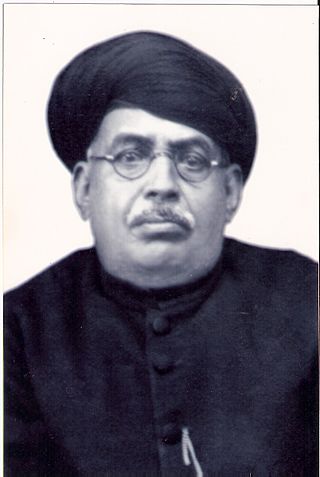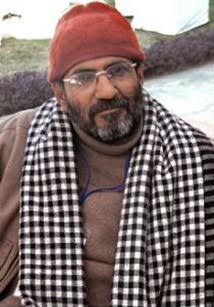Related Research Articles

Devanagari is an Indic script used in the northern Indian subcontinent. Also simply called Nāgari, it is a left-to-right abugida, based on the ancient Brāhmi script. It is one of the official scripts of the Republic of India and Nepal. It was developed and in regular use by the 7th century CE and achieved its modern form by 1000 CE. The Devanāgari script, composed of 48 primary characters, including 14 vowels and 34 consonants, is the fourth most widely adopted writing system in the world, being used for over 120 languages.

Hindustani is an Indo-Aryan language spoken in North India, Pakistan and the Deccan, and used as a lingua franca in both countries. Hindustani is a pluricentric language with two standard registers, known as Hindi and Urdu. Thus, it is also called Hindi–Urdu. Colloquial registers of the language fall on a spectrum between these standards. In modern times, a third variety of Hindustani with significant English influences has also appeared which is sometimes called Hinglish or Urdish.

Gujarati is an Indo-Aryan language native to the Indian state of Gujarat and spoken predominantly by the Gujarati people. Gujarati is descended from Old Gujarati. In India, it is one of the 22 scheduled languages of the Union. It is also the official language in the state of Gujarat, as well as an official language in the union territory of Dadra and Nagar Haveli and Daman and Diu. As of 2011, Gujarati is the 6th most widely spoken language in India by number of native speakers, spoken by 55.5 million speakers which amounts to about 4.5% of the total Indian population. It is the 26th most widely spoken language in the world by number of native speakers as of 2007.

The Newberry Library is an independent research library, specializing in the humanities. It is located in Chicago, Illinois, and has been free and open to the public since 1887. The Newberry fosters a deeper understanding of our world by inspiring research and learning in the humanities and encouraging conversations about ideas that matter. Its mission is rooted in a growing and accessible collection of rare and historical materials.

Saraiki is an Indo-Aryan language of the Lahnda group, spoken by 26 million people primarily in the south-western half of the province of Punjab in Pakistan. It was previously known as Multani, after its main dialect.
Choudhri Mohammed Naim is an American scholar of Urdu language and literature. He is currently professor emeritus at the University of Chicago.

Rajasthani languages are a branch of Western Indo-Aryan languages. It is spoken primarily in the state of Rajasthan and adjacent areas of Haryana, Gujarat and Madhya Pradesh in India. There are also speakers in the Pakistani provinces of Punjab and Sindh. Rajasthani is also spoken to a lesser extent in Nepal where it is spoken by 25,394 people according to the 2011 Census of Nepal.

Mewari is a dialect of the Rajasthani languages. It is spoken by about five million speakers in Rajsamand, Bhilwara, Udaipur, Chittorgarh and Pratapgarh districts of Rajasthan state and Mandsaur, Neemuch districts of Madhya Pradesh state of India.

Rahul Sankrityayan was an Indian author, essayist, playwright, historian, scholar of Buddhism who wrote in Hindi and Bhojpuri. Known as "father of Hindi travel literature", Sankrityayan played a pivotal role in giving Hindi travelogue a literary form. He was one of the most widely travelled scholars of India, spending forty-five years of his life on travels away from his home in locations like Russia, Tibet, China, Central Asia, etc.

Gaurishankar Hirachand Ojha, born in Rohida village of Sirohi District, was a historian from the Indian state of Rajasthan. A prolific author, he wrote several books on the history of Rajasthan and other historical subjects. Subsequent historians from Rajasthan have referred to him as Guruvara Mahamahopadhyaya. Ojha regarded Kaviraj Shyamaldas as his guru and worked under him as assistant secretary of the historical department, Udaipur
The University of British Columbia Library is the library system of the University of British Columbia (UBC). The library is one of the 124 members of the Association of Research Libraries (ARL). In 2017, UBC Library ranked 29th among members of the ARL for the number of volumes in library, making it the third largest Canadian academic library after the University of Toronto and the University of Alberta. However, UBC Library ranked 23rd for the titles held and second in Canada, and had a materials expenditures of $13.8 million, placing it 44th.

Dingal, also known as Old Western Rajasthani, is an ancient Indian language written in Nagri script and having literature in prose as well as poetry. It is a language of very high tone and requires a specific style of speaking. Dingal was used in Rajasthan and adjoining areas including Gujarat, Kutch, Malwa, and Sindh. Most of Dingal literature is said to be composed by Charans. It was prominently used in composition of war poetry praising the martial exploits of Rajput and Charan war heroes.

Colin Paul Masica was an American linguist who was professor emeritus in the Department of South Asian Languages and Civilizations and the Department of Linguistics at the University of Chicago. Besides being a specialist in Indo-Aryan languages, much of his work was on the typological convergence of languages belonging to different linguistic families in the South Asian area and beyond, more broadly on this phenomenon in general, and on possible explanations for it and implications of it in connection with both linguistic and cultural history.
Sitaram Lalas was a linguist and lexicographer of India.

Devarshi Kala Nath Shastry was born on 15 July 1936. He is a Sanskrit scholar and was honoured by the President of India in 1988. He is an Indologist and a prolific writer in Sanskrit, Hindi and English, and a well-known linguist, who has contributed to the campaign of evolving technical terminology in Indian languages and ensuring a respectable status for Hindi, the official language of his state and the Indian union.

Dr. Arjun Deo Charan is a Rajasthani poet, critic, playwright, theatre director and translator. A prominent figure in Indian theatre, he is among the country's top 10 theatre personalities.

MahamahopadhayayaKaviraja Shyamaldas Dadhivadia (1836-1893), popularly referred to as Kaviraja was one of the early writers involved in documenting the history and culture of what is now Rajasthan region of India.
Peter E. Hook is professor emeritus in the Department of Asian Languages and Cultures at the University of Michigan.
Bhanwar Singh Samaur is an Indian writer, poet, historian, and social worker from Rajasthan. Samaur is the recipient of the Sahitya Akademi Award 2020 for his work Sanskriti ri Sanatana Deeth. His career has spanned more than 50 years including works on history, literature, and poetry in Rajasthani as well as Hindi. Dr. Samaur is a retired Hindi Lecturer from Lohia Postgraduate College, Churu.
Shakti Dan Kaviya was a poet, writer, critic, and scholar from Rajasthan, India. Kaviya had served as the department head of Hindi as well as Rajasthani section multiple times at Jai Narain Vyas University. He was considered an authority in Dingal (Rajasthani) literature as well as a great scholar of Hindi and Braj-Bhasha. Kaviya was also a Sahitya Akademi Award recipient for his work 'Dharti Ghani Rupali'
References
- ↑ "University of Chicago website, South Asia at Chicago, accessed 2009-04-04". Archived from the original on 11 February 2009. Retrieved 5 April 2009.
- ↑ The University of Chicago Library, "About the Southern Asia Collection" , accessed 2009-04-04